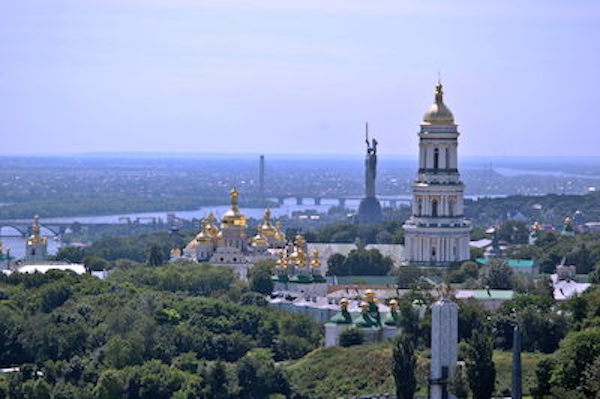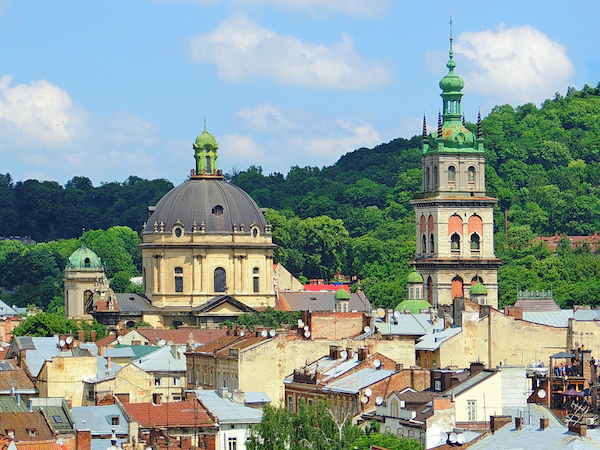


Ukraine used to attract more than 20 million foreign citizens every year (23 million in 2012). But since 2014 this has lowered to about 10 million. Visitors primarily come from Eastern Europe, but also from Western Europe as well as Turkey and Israel.
Ukraine is a destination on the crossroads between central and eastern Europe, between north and south. It borders Russia and is not far from Turkey. It has mountain ranges – the Carpathian Mountains suitable for skiing, hiking, fishing and hunting. The coastline on the Black Sea is a popular summer destination for vacationers. Ukraine has vineyards where they produce native wines, ruins of ancient castles, historical parks, Orthodox, Catholic and Protestant churches as well as a few mosques and synagogues. Kiev, the country's capital city has many unique structures such as Saint Sophia Cathedral and broad boulevards. There are other cities well known to tourists, such as the harbour town Odesa and the old city of Lviv in the west. Most of Western Ukraine, which used to be within the borders of the Republic of Poland before World War II, is a popular destination for Poles. Crimea, a little "continent" of its own, had been a popular vacation destination for tourists for swimming or sun tanning on the Black Sea with its warm climate, rugged mountains, plateaus and ancient ruins, though the t ourist trade has been severely affected by Russia's occupation and annexation of the territory in 2014. Cities there include: Sevastopol and Yalta – location of the peace conference at the end of World War II. Visitors can also take cruise tours by ship on the Dnieper River from Kiev to the Black Sea coastline. Ukrainian cuisine has a long history and offers a wide variety of original dishes.

“Everything Starts in Kyiv” is the Ukrainian capital’s official promotional motto and even if your exploration of Ukraine doesn’t start here it certainly is a “must see and experience” destination during your visit. Did you know that in the 11th century Kyiv was the largest city in Europe? Kyiv, of course, is known internationally as the “City of Golden Domes” for the glistening cupolas of such ancient Ukrainian Orthodox places of worship as St. Sophia’s, St. Michael’s and the Monastery of the Caves. But Kyiv is not just a city of beautiful historic churches and other architectural treasures that dot the horizon along the banks of the mighty Dnipro River. It is the center of the country’s bustling modern-day business activity and tumultuous politics as well as its biggest metropolis, with a vibrant classical and contemporary cultural scene. Kyiv is considered one of the greenest cities in Europe with more than 100 parks and nearly 500 public gardens.



“Ukraine’s most famous port city is Odesa, which is situated on the north coast of the Black Sea. It was founded in 1794 by Russian Empress Catherine the Great and today is a leading center of culture, trade and tourism. Its early successful development is attributed to Frenchman Duc de Richelieu, who served as the city’s governor between 1803 and 1814. As a free port, Odesa attracted many nationalities. By 1897 Jews made up over a third of the city’s population. Mark Twain visited Odesa in 1867 and wrote: “I have not felt so much at home for a long time as I did when I… stood in Odessa for the first time.” When in Odesa be sure to climb the 142-meter Potemkin staircase, an entrance to the city from the direction of the sea; and take a stroll along Derybasivska Street, a lively pedestrian walkway named after the city’s first mayor. A performance of the highly-respected Odesa Philharmonic Orchestra conducted by American Hobart Earle should also be on your agenda.



If Ukraine has a city that can naturally bear the title of “Gateway to the West” it is certainly Lviv – not only due to its physical proximity to neighboring countries of the European Union (it’s only about 70 kilometers from the border with Poland) but also because it was part of the Austrian Hapsburg Empire from 1772 to 1918. Lviv also spent several centuries under Polish rule. These Western influences have left an indelible mark on Lviv’s architecture, culture and cuisine. The central “old town” part of the city is designated a UNESCO World Heritage Site and nearly every weekend a festival is held here. Nestled among and within these historic buildings are dozens of delightful cafes and restaurants. Yuriy Kulchytsky, a native son of the Lviv region, is considered by many to be the progenitor of Viennese coffee culture, establishing the first coffeehouse in that city in 1683. Today Lviv is a leading center of higher education and of Ukraine’s IT industry.



Although Kharkiv may not be on everyone’s list of top tourist destinations in Ukraine due to its traditional industrial economic base—it does have an architecturally impressive city center and a dynamic, youthful vibe, thanks in large part to its huge university-student population. Make sure to check out the delightful archeological museum within the Karazin Kharkiv National University campus and the unique Constructivist design of the adjacent Derzhprom building. From 1919 to 1934 Kharkiv was the capital of the Ukrainian Soviet Socialist Republic and the center of a government-led cultural revival which ended tragically with the imposition of Stalin’s ruthless totalitarian policies, including the Holodomor. Today Kharkiv proudly wears the mantle of Ukraine’s Second City and hosts the annual Kharkiv (Classical) Music Festival.


Mariia Avramova 11 May 2020